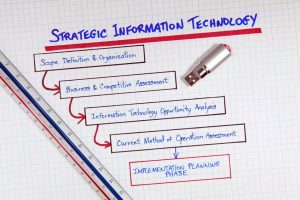Podcast: Play in new window | Download
Subscribe: RSS
Today’s expert, Craig Clawson, talks with us about strategic planning in IT.
Strategic planning is for any size organization and looks 3-5 years down the road as to technology and other needs.

Scale, for example, is a critical issue of your company is going to take off. Even if you are dealing with a database of 100 customers are you comfortable you can manage the data? What about data corruption where an employee incorrectly closes a database?
Consider a fractional CIO from the beginning.
IT Strategic Planning:
- synchronizes the planning of technology with the organizations mission
- defines the methods of security and stability allowing the organization to move into the future
- it provides a framework for planning what to do when problems arise
- depending upon one’s industry certification requirements may require having an IT strategic plan, e.g., finance, health care, or the non-profit space
The 5 levels of the Department of Defenses Capability Maturity Model (CMM) was discussed
- chaotic
- repeatable processes – someone knows how to solve the problem
- defined – standard written procedures (most organizations can get to this level)
- managed – metrics and KPIs are defined around particular applications or processes
- optimizing – anticipating problems before they occur and planning/acting accordingly via root cause analysis or other methods
Craig discussed the hype cycle revolving around the latest, new technology that’s going to solve all our problems. He uses the Internet of Things (IoT) and cloud computing as examples. They fail to deliver even 1/2 of what was promised and the performance drops on the CMM. Because of this taking some time to see what the fallout is discovered by early adopters is important.
Even if you’re just a 1 or 2 person shop consider IT strategic planning as part of your overall strategic plan. Do it from a CIO position not from a tech-guy position.
Without an IT strategic plan there is the risk your staff will do what they fell is best from a tactical level.
If choosing to use a fractional CIO remember they need time to get up to speed with your organization.
The conversation then turned to the politics of employees vs outside managed service providers (MSP) vs a fractional CIO. It’s important to keep in mind that the CIO’s outsider’s perspective can help the company avoid tunnel vision and hurting itself. Also, with executive support, the CIO can direct the MSP’s activities in a manner appropriate for your company. And the employee’s voice is important but it needs to stay within the bounds of the mission statement the company has set for itself.
Problems may be due simply to a fear of change.
Craig can be reached at:
craig.b.clawson@gmail.com
(c) 614-859-6328
https://www.linkedin.com/in/craigbclawson/
For more information on the “8 Steps From Chaos To Clarity and Calm: CEO Advanced Training” go to
https://www.ctrchg.com/ceo-advanced-training/
Your feedback is important. Choose from the following options:
- place a review in iTunes,
- click on “leave a comment” below,
- send any comments along with your name and the show number to support@ctrchg.com or
- call us at 614-388-8917 and leave a message including your name, the podcast number and podcast title.
Listen to future episodes for our reply.


Recent Comments